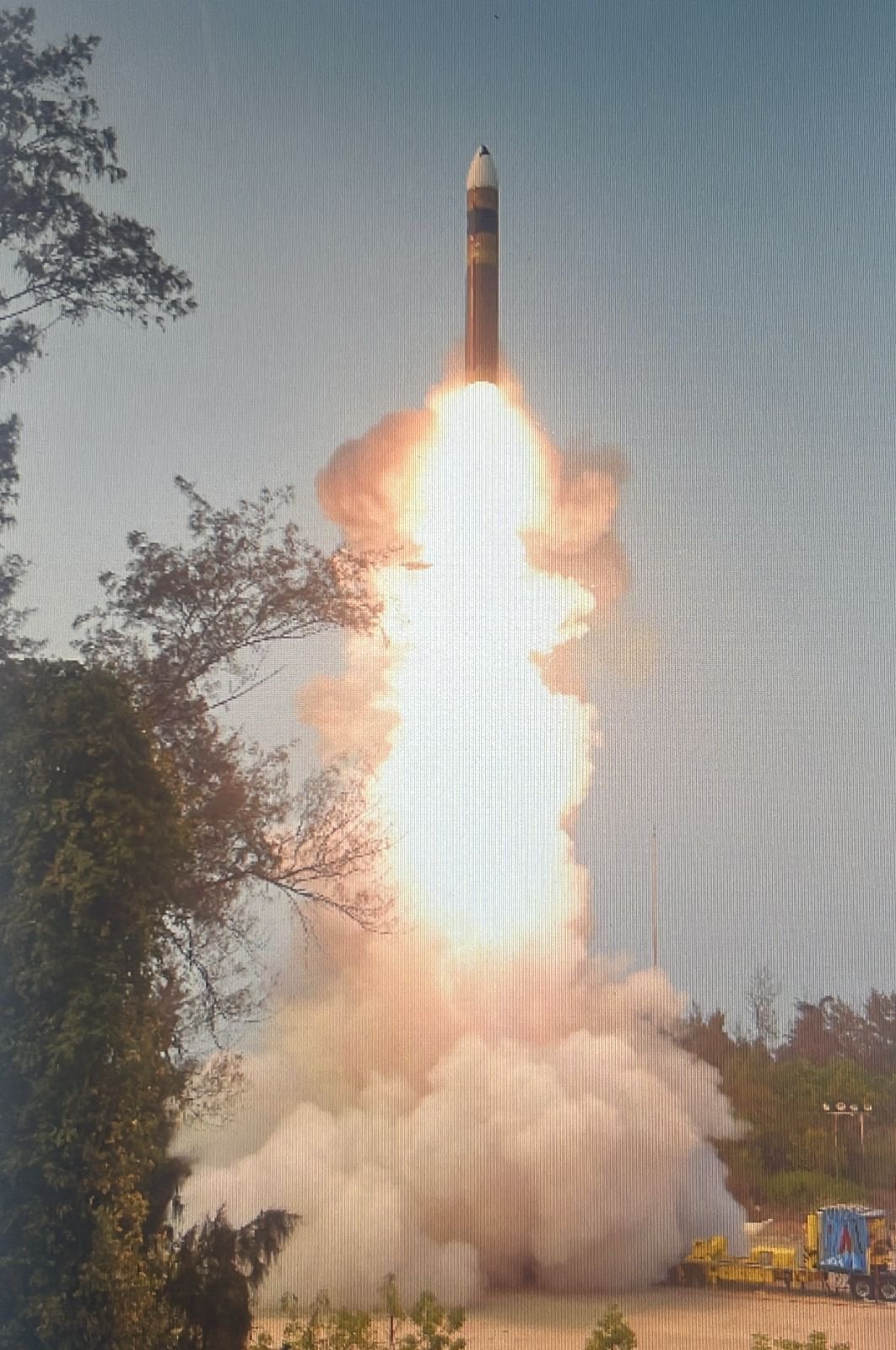Agni-5: What is the missile launched by India and will it lead to regional arms race?
India conducts first flight test of long-range ballistic missile that can deliver multiple nuclear warheads. But defence analysts fear it could do more harm than good to Asia-Pacific security. Shweta Sharma reports


India says it has successfully conducted its first test flight of a homegrown long-range ballistic missile capabale of delivering multiple warheads to different targets, a significant development for the country’s weapons programme.
Prime minister Narendra Modi took to X – formerly Twitter – to congratulate the scientists behind the Agni-5 missile, which derives its name from the Sanskrit language word for “fire” and is equipped with Multiple Independently Targetable Re-entry Vehicles (Mirv) technology.
It puts India among a relatively small club of countries including the US, Russia, China, France and the UK that are known to have Mirv-equipped missiles.
The missile’s range of over 5000km and its general utility as a potential “first use” weapon in instigating a conflict have led experts to express concerns that the test will “trigger an arms race in the region and lead to increased instability over time”, one analyst told The Independent.
The Agni-5 missile, developed by India’s military research wing, took its maiden flight test in April 2012 and since has been tested multiple times, every time with added technological advancements.
The missile isn’t quite an intercontinental ballistic missile (ICBM) which has a range greater than 5,500km. However its 5,000km range still covers the whole of Pakistan, China and much of the wider Asia neighbourhood. Details about its exact range and how many warheads it can carry have not been made public.
Mirv technology was first developed in the 1970s by the US, and provides strategic advantages because of its capability to overcome ballistic missile defences by inundating the adversary’s defence systems.
“This missile test is unique. So far, all eight tests done on Agni missiles had a single warhead, which means one missile was carrying one warhead. The latest missile was unique in the sense that it had Mirv technology,” Saurabh Todi, research analyst at the Takshashila Institution, tells The Independent.

This capability is important, he explains, as a ballistic missile equipped with Mirv is launched from a designated location, typically from a land-based silo, a submarine, or an aircraft. As the missile exits the Earth’s atmosphere and reaches the designated altitude, it releases the Mirv payload. Each warhead separates from the missile body, typically using small rockets or a release mechanism, and has its own propulsion and guidance system, allowing it to manoeuvre independently towards its designated target. This enables a single missile to strike multiple targets simultaneously or within a short timeframe.
Defence analysts have questioned the need for Mirv and the timing of the test, which was announced just days before India’s election commission is expected to declare the start of the campaign period ahead of the country’s general election, in which Mr Modi’s Bharatiya Janata Party (BJP) is vying for a third straight term.
Experts questioned the utility of Mirv technology, which is seen as being most useful for first strikes, as India like China has a “no first use” policy when it comes to nuclear weapons. India’s nuclear doctrine is based on credible minimum deterrence that underlines that the country has only second-strike capability, fulfilling the bare needs of defence and security.
Derek Grossman, a senior defense analyst focused on national security policy and the Indo-Pacific, says it is a “great scientific and technological achievement” but fears it will trigger an arms race in the region and lead to increased instability over time, rather than effectively addressing potential international threats.
“I’m not sold on the need for India to invest in this technology just based on the threat landscape. When you look at the international landscape, China is continuing to develop their nuclear programme and they are in early stages of having a ballistic missile defence, Russia is a friend, and you already have a conventional advantage against Pakistan,” Grossman tells The Independent.
“But there is a prestige issue here and that India wants to be part of the nuclear club, not just in terms of having nuclear weapons, but having technologies associated with nuclear weapons,” he says.
He says the timing of the Indian announcement cannot be ignored, adding that it could be a political decision to appease the domestic audience and appeal to a sense of patriotism ahead of the election.
The latest missile tries to level the playing field with China to some extent, he says.
China already has missiles such as the Dong Feng-41 with a range of 12,000-15,000km, capable of hitting any Indian city. China has significantly increased its military budget by 7.2 per cent this year, marking the biggest jump in five years. It is increasing its military spending for 2024 to 1.67 trillion yuan (£181.7bn).
But does the Agni-5 give India an edge over China?
Grossman says “no”. “Maybe in the short term it can benefit to show that there’s this kind of provable capability that they can hit multiple targets with nuclear weapons,” he says.
“But in the end, China is going to come up with improvements to its own defences and it’s already expanding its offensive capabilities. In that way, it is not going to bolster stability in the region.”
Tensions between India and China, which fought a war in 1962 over longstanding territorial disputes, have worsened over the years and reached the worst point in decades in 2020 as a brutal skirmish between soldiers in the disputed Himalayan region led to deaths on both sides.
Since then, the two countries have amassed thousands of soldiers on their de facto border and repositioned artillery and howitzers to the region.
Christopher Clary, associate professor of political science at the University at Albany, tells The Independent that the Agni-5, with or without Mirv, puts China into India’s target range.
“India’s challenge is that major Chinese cities, including importantly Beijing, are far away from India. Beijing is roughly 2,400km from the easternmost Indian state of Arunachal Pradesh and 4,000km from central India,” he says.
“India has had relatively few missiles with the range necessary to hold such east coast Chinese cities at risk. Long-range missiles are expensive. More expensive than nuclear warheads in the experience of many nuclear weapons states.
“So a missile that permits delivery of more than one warhead can ensure the ability to strike far away at lower cost than building multiple missiles each with one warhead at their top,” he says.
Experts said it would still be some time before India can induct this new missile technology into its strategic nuclear forces. “The government has not yet revealed how many warheads were aboard the Agni-5 test, which will give some indication of how well India has been able to miniaturize its nuclear warheads,” Clary says.
Join our commenting forum
Join thought-provoking conversations, follow other Independent readers and see their replies
Comments